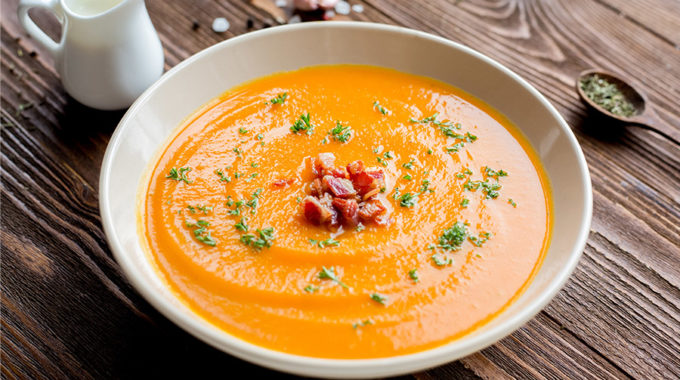Beet Soup This soup was created by Deborah Madison, one of the best cookbook writers…

Recipe: Butternut Squash Soup
By Ellen Green
This super simple, rib-sticking soup is one of my go-to dishes in the winter, and I always have a few jars in the freezer for emergencies. It’s a good base for other recipes–last week in the Open Table kitchen, we used this recipe as a sauce for pasta and Italian sausage; it’s divine over ravioli or gnocchi; and it makes an unusual but delicious sauce for casseroles. And play around with the ingredients! Change the nuts, spices, and garnish to suit your family’s tastes, or to accommodate what happens to be in your pantry today. Almonds and curry with a swirl of yogurt? Sure. Peanuts, chipotle, and crumbled bacon? Yep, I’ve tried it, it’s good. Macadamia nuts and coconut with a lime wedge? Amazing!
Here’s the recipe I usually make, in keeping with my Northern Italian roots. I’ve included directions for stovetop only and for oven/stovetop (easier if cutting squash is a challenge for you).
→ about 2 hours total, 45 minutes active
→ serves 6-8 (easy to multiply the recipe and make a big batch)
→ equipment: big knife, vegetable peeler or paring knife, cutting board, sturdy spoon, soup pot, large baking dish (oven method), blending device (blender, food processor, food mill, sieve, or potato masher)
Ellen’s Butternut Squash and Chestnut Soup
Ingredients
- 3 ½ to 5 lb whole butternut squash (1 medium squash or 2 small ones–see ingredient note)
- ¼ cup olive oil, butter, or other cooking fat
- 1 large yellow onion, peeled and sliced
- 1 large carrot, peeled or scrubbed and cut into 1 inch pieces
- 1 large stalk of celery, cut into 1 inch pieces
- 2 large cloves of garlic, smashed and peeled
½ teaspoon kosher salt or ¼ teaspoon table salt, plus more to taste - a sprig of fresh thyme about the size of your hand, or ½ teaspoon dried
- 1-2 bay leaves
- ¼ tsp black pepper, plus more to taste
- 12 oz peeled roasted chestnuts (see ingredient note)
- 1 cup dry white wine or hard cider (optional)
- 4-8 cups vegetable or chicken broth, preferably low-sodium
- about 1 cup heavy cream or half-and-half (optional–for a creamier dairy-free soup, use coconut cream or more chestnuts)
Ellen’s favorite garnish:
- ½ lb Italian sausage (bulk or taken out of its casings), sweet or hot
- ¼ cup fresh sage, sliced into strips
Stovetop Only Method
- Prepare the squash: peel it, scoop out and discard the seeds, and cut it into 1 inch cubes.
Strategy a: use a sturdy Y-shaped vegetable peeler to peel the squash, then halve it lengthwise, scoop it, and cube it.
Strategy b: halve the squash lengthwise, scoop it, and cut it into 1 inch half-moons. Use a paring knife to peel each piece, then cut into cubes. - Prepare your other vegetables.
- Melt the oil in a large pot over medium heat. Add the onion, carrot, celery, garlic, and salt. Saute until the onions are soft and starting to color slightly, about 5-10 minutes.
- Add the thyme, bay leaves, and pepper, and saute until fragrant–about a minute.
4a. If you’re using wine/cider, pour it in now, and scrape the bottom vigorously while it boils for a minute or so. - Add the squash and chestnuts, and enough broth to just cover them. (Supplement the broth with milk or water if necessary.) Cover the pot. Raise the heat to bring the soup to a boil, then lower it so that the soup simmers briskly. Simmer for about 45 minutes, or until the squash and carrot are very soft.
- Interlude: prepare the garnish
Sauté the sausage in a pan over medium heat until it’s nice and crispy and brown–if necessary, deglaze the pan with a couple tablespoons of water from time to time to prevent scorching. When the sausage is almost done, add the sage and cook until the sage is crisped. - Remove the bay leaves and thyme stem. Let the soup cool for at least 30 minutes, or up to 48 hours, then puree it…
Masher and strainer strategy: pour the soup through a fine strainer into a large bowl or pot. Return the drained solids to the soup pot and mash as finely as you can with a potato masher, then press them through the strainer into the liquid with the back of a spoon.
Food mill strategy: ladle the soup through a food mill until the mill is full. Turn the mill until it’s empty, then pour more of the soup through. Repeat until you’ve milled all the soup.
Food processor or blender strategy: puree the soup in batches–I recommend cooling it to room temperature or cooler if you’re using a food processor. - Rinse the pot and return the soup to it.
- Heat the soup to a simmer. Add the cream, and more broth if you’d like a thinner soup. Bring it back to a bare simmer, taste, and adjust the seasonings. Serve in deep bowls with a spoonful of the garnish on top.
Oven and Stove Method
- Preheat your oven to 375F. Put the whole squash in a baking dish–if you can cut it in half lengthwise, this will go a little faster (put it cut side down). Bake for 45-75 minutes, or until you can pierce it with a fork with no resistance. (Move down to step 3 while you wait!) Let it cool enough to handle.
- Halve the squash lengthwise. Scoop the seeds out of the squash and discard them, and scoop the squash flesh out of its skin. Mash the squash flesh with a potato masher and set it aside.
- Prepare your other vegetables.
- Heat the oil in a large pot over medium heat. Add the onion, carrot, celery, garlic, and salt. Saute until the onions are soft and starting to color slightly, about 5-10 minutes.
- Add the thyme, bay leaves, and pepper, and saute until fragrant–about a minute.
5a. If you’re using wine/cider/beer, pour it in now, and scrape the bottom vigorously while it boils for a minute or so. - Add the chestnuts, and enough broth to cover them by about an inch. (Supplement the broth with milk or water if necessary.) Cover the pot. Raise the heat to bring the soup to a boil, then lower it so that the soup simmers briskly. Simmer for about 45 minutes, or until the carrot is very soft. Add the squash and stir it in.
Refer to the steps for the stove-only method, starting with interlude, to finish the soup.
To freeze: cool the soup to room temperature, then pack it into jars or containers with tight lids, leaving at least an inch of space at the top. Freeze for up to 6 months. Defrost in the microwave on low power, or in a bowl of water under a dripping tap.
Ingredient Notes:
Squash: Butternut squash is best for this recipe–it has a lot of squash flavor, but isn’t too sweet. I’ve also used hubbard squash, cooking pumpkin (ask your produce seller if you aren’t sure which pumpkins are cooking pumpkins), acorn squash, and kabocha–other squashes don’t have the right flavor or texture for this recipe. Whatever squash you use, make sure it’s ripe and fresh. A farmstand will usually have the best squash for the best price. Look for heavy, unblemished butternut squash without any green streaks near the stem; round squash should sound hollow when you knock on them. Don’t use precut or frozen squash for this recipe–the flavor degrades quickly once it’s cut.
Chestnuts: easiest to get online. I’ve had the best luck with bagged, shelf-stable chestnuts (refrigerate or freeze after opening them), but I’ve used canned and vacuum-packed, and they all work. If you want to spend a few hours chatting over a mundane task, Asian grocery stores often have fresh whole chestnuts outside the holiday season. If you live near a farm, it’s worth asking if they have a tree–those are the most work, but they’re the best.
If you’re using other nuts, I recommend toasting them before adding them. A diced russet potato or ricotta cheese (let it sit in a mesh strainer for a couple hours to dry out a little) is also a fine substitute. But do try it once with chestnuts if you can get them–the flavor is unique and really makes this soup work, in my opinion.



